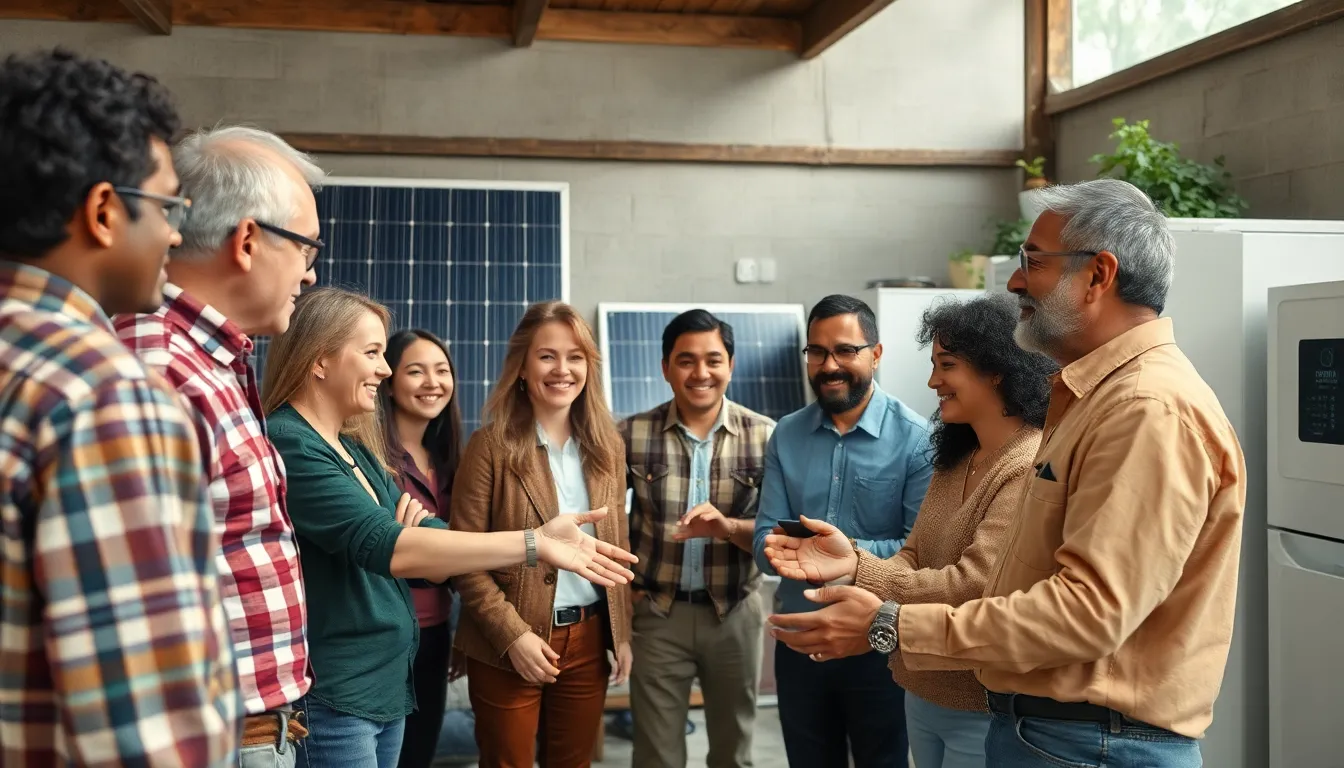In a world where the latest gadgets seem to come with a side of guilt, sustainable technology is the superhero we didn’t know we needed. Imagine a future where your smartphone not only connects you to your friends but also helps save the planet. Sounds like a sci-fi movie, right? Well, it’s happening now, and it’s time to join the green revolution without sacrificing your tech-savvy lifestyle.
Sustainable technology isn’t just a buzzword; it’s a game-changer. From energy-efficient appliances to eco-friendly materials, these innovations promise to reduce our carbon footprint while keeping our lives convenient and connected. So buckle up and get ready to explore how these advancements can make Mother Earth proud—while you enjoy the perks of being a modern-day eco-warrior. Who knew saving the planet could be this cool?
Table of Contents
ToggleOverview of Sustainable Technology
Sustainable technology encompasses innovations aimed at minimizing environmental impact while meeting human needs. This branch of technology includes energy-efficient appliances, renewable energy systems, and eco-friendly materials. Innovations in this field often reduce resource consumption and lower greenhouse gas emissions.
Energy-efficient appliances, such as LED light bulbs or Energy Star-rated refrigerators, consume less electricity than traditional models. By adopting these technologies, consumers can decrease their energy bills and support a more sustainable lifestyle. Renewable energy systems, including solar panels and wind turbines, harness natural resources to generate clean energy, significantly reducing reliance on fossil fuels.
Eco-friendly materials, such as bioplastics and recycled metals, play a crucial role in sustainable technology. These materials promote sustainable production practices and help decrease waste in landfills. Several companies now prioritize sustainable sourcing, reflecting a broader shift toward responsible manufacturing.
Sustainable technology also emphasizes the importance of product lifecycles. Many devices are designed for durability, encouraging repairs and recycling rather than disposal. This approach not only conserves resources but also fosters innovation in design and production processes.
Governments worldwide support sustainable practices through legislation and incentives, creating an environment for green technologies to flourish. As businesses and consumers embrace sustainable solutions, the demand for eco-friendly innovations continues to rise.
The future of sustainable technology holds immense potential for fostering a balanced relationship between modern conveniences and environmental stewardship. By investing in these technologies, society can move toward a greener, more sustainable future.
Key Principles of Sustainable Technology

Sustainable technology focuses on minimizing environmental effects while enhancing human well-being. Three key principles guide this approach: environmental impact, economic viability, and social responsibility.
Environmental Impact
Environmental impacts are central to sustainable technology. Innovations like energy-efficient appliances and renewable energy systems significantly reduce carbon emissions. For instance, transitioning from traditional light bulbs to LED bulbs can lower energy consumption by up to 80%. Renewable sources, such as solar panels, further decrease reliance on fossil fuels, demonstrating a clear advantage for the planet. Additionally, using eco-friendly materials minimizes waste in landfills, promoting a circular economy. These practices collectively transform how technology interacts with the environment.
Economic Viability
Sustainable technology also emphasizes economic viability. Investing in green technologies often generates long-term savings. Energy-efficient appliances, for example, lead to lower utility bills. The initial cost of solar panels may seem high, but savings on energy costs can balance that investment within a few years. Furthermore, as governments introduce incentives for green innovations, businesses find it increasingly beneficial to adopt sustainable practices. This shift not only reduces overhead costs but enhances competitiveness in a market that values eco-consciousness.
Social Responsibility
Social responsibility plays a crucial role in sustainable technology. Companies focus on ethical sourcing of materials, ensuring fair labor practices and minimal environmental harm. Consumers increasingly prefer brands that prioritize sustainability, influencing market trends. Engaging communities in sustainable initiatives fosters awareness and responsibility toward environmental issues. Moreover, education on sustainable practices empowers individuals to make informed choices. This collective approach cultivates a culture where technology enhances livelihoods while safeguarding the planet for future generations.
Types of Sustainable Technology
Sustainable technology encompasses various innovations that aim to reduce environmental impact while enhancing efficiency. It includes renewable energy solutions, sustainable agriculture practices, and waste management innovations.
Renewable Energy Solutions
Renewable energy solutions harness natural resources to produce clean energy. Solar panels convert sunlight into electricity, while wind turbines utilize wind currents for power generation. Hydropower systems tap into flowing water to generate energy, contributing to reduced fossil fuel reliance. Geothermal energy systems extract heat from beneath the Earth’s surface, providing a consistent energy source. Implementing these technologies significantly lowers carbon emissions and promotes energy independence.
Sustainable Agriculture Practices
Sustainable agriculture practices focus on producing food while protecting the environment. Crop rotation diversifies farming, reducing the need for chemical inputs. Organic farming eliminates synthetic fertilizers and pesticides, enhancing soil health. Integrated pest management employs biological pest control methods, minimizing harm to ecosystems. Additionally, agroforestry combines agriculture with forestry, promoting biodiversity. These approaches not only yield nutritious food but also foster resilience against climate change and protect vital resources.
Waste Management Innovations
Waste management innovations aim to reduce, reuse, and recycle to minimize landfill impact. Smart waste bins equipped with sensors optimize collection routes, reducing carbon footprints. Composting technologies transform organic waste into valuable soil amendments. Recycling programs facilitate the recovery of materials like plastics, metals, and paper, promoting circular economy principles. E-waste recycling processes reclaim valuable metals, preventing environmental contamination. Implementing these innovations leads to more sustainable and efficient waste management systems.
Challenges in Sustainable Technology Adoption
Sustainable technology faces several challenges that hinder its widespread adoption.
Economic Barriers
High initial costs often deter individuals and businesses from investing in sustainable technologies. Significant financial investment is required for renewable energy systems and energy-efficient appliances. Many consumers perceive eco-friendly products as expensive compared to conventional options. Limited access to affordable financing also restricts lower-income households from adopting green technologies. Furthermore, shorter-term cost savings lack visibility, making it difficult to justify the upfront expense in the eyes of potential adopters.
Technological Limitations
Technological limitations pose another barrier to sustainable technology adoption. Existing infrastructure may not support the integration of new green solutions, limiting their effectiveness. Additionally, many renewable energy systems depend on consistent weather conditions, which can hinder reliability. Innovations in storage technologies, like batteries, require further development to ensure energy efficiency. Moreover, knowledge gaps regarding the operation and maintenance of sustainable technologies remain prevalent among consumers and businesses.
Policy and Regulatory Challenges
Policy and regulatory challenges also impact the adoption of sustainable technologies. Lack of supportive legislation can stifle innovation and slow market growth. Incentives for renewable energy use often vary widely, creating uncertainty among potential adopters. Moreover, regulatory frameworks may lag behind technological advancements, complicating implementation. Many regions lack standardized guidelines for sustainable technology, leading to confusion and resistance among stakeholders.
Future Trends in Sustainable Technology
Innovations in sustainable technology continue to shape environmental strategies and solutions. Anticipated advancements focus on enhancing efficiency and reducing ecological footprints.
Emerging Innovations
Breakthroughs in renewable energy storage technologies enhance reliability, making it easier to utilize solar and wind power. Smart grids incorporate artificial intelligence, optimizing energy distribution and reducing wastage. Biodegradable materials offer alternatives to plastics, significantly curbing pollution. Innovations in carbon capture systems aim to lower greenhouse gas emissions from industrial processes. Electric vehicle advancements support wider adoption, reducing reliance on fossil fuels. Blockchain technology assists in tracking supply chains, promoting transparency in sustainable sourcing. Together, these developments propel industries toward greener practices while addressing pressing environmental concerns.
Global Initiatives and Collaborations
International agreements like the Paris Accord unite countries in the fight against climate change. Partnerships between governments and private sectors drive initiatives focused on clean energy adoption. Non-governmental organizations advocate for sustainable practices, raising awareness and urging action across communities. Collaborative research projects concentrate on sustainable agriculture, offering insights and sharing best practices globally. Cross-border investments in green technologies stimulate economic growth, fostering innovation and sustainability worldwide. These collective efforts are crucial for enhancing sustainable technology’s impact on global ecosystems.
Sustainable technology represents a pivotal shift towards a greener future. By integrating eco-friendly practices into everyday life, individuals and businesses can significantly reduce their environmental impact. This transition not only fosters innovation but also promotes economic growth and social responsibility.
As the demand for sustainable solutions rises, the potential for positive change becomes even more apparent. Embracing renewable energy, energy-efficient appliances, and sustainable materials empowers consumers to make informed choices.
With ongoing advancements and supportive policies, the journey toward a sustainable tech-driven world is not just a possibility; it’s an imperative for future generations. The time to act is now, and every small step contributes to a larger movement towards environmental stewardship.




